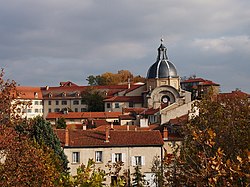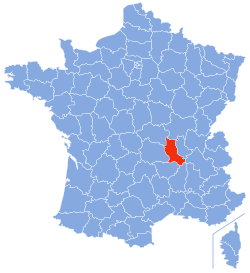Loire (department)
Loire
| |
|---|---|
 Montbrison in 2007 | |
 Location of Loire in France | |
| Coordinates: 45°05′N 04°05′E / 45.083°N 4.083°E | |
| Country | France |
| Region | Auvergne-Rhône-Alpes |
| Prefecture | Saint-Étienne |
| Subprefectures | Montbrison Roanne |
| Government | |
| • President of the Departmental Council | Georges Ziegler[1] (LR) |
| Area | |
| • Total | 4,781 km2 (1,846 sq mi) |
| Population (2021)[2] | |
| • Total | 769,029 |
| • Rank | 30th |
| • Density | 160/km2 (420/sq mi) |
| Demonym | Ligerians |
| Time zone | UTC+1 (CET) |
| • Summer (DST) | UTC+2 (CEST) |
| Department number | 42 |
| Arrondissements | 3 |
| Cantons | 21 |
| Communes | 323 |
| ^1 French Land Register data, which exclude estuaries and lakes, ponds and glaciers larger than 1 km2 | |
Loire (/lwɑːr/; French pronunciation: [lwaʁ]; Arpitan: Lêre; Occitan: Léger or Leir) is a landlocked département in the Auvergne-Rhône-Alpes region of France occupying the river Loire's upper reaches. Its prefecture is Saint-Étienne. It had a population of 765,634 in 2019.[3]
History
[edit]Loire was created in 1793 when the Rhône-et-Loire département was split into two, about three years after it was created in 1790. This was a response to counter-revolutionary activities in Lyon which, by population, was the country's second largest city. By splitting Rhône-et-Loire the government sought to protect the French Revolution from the potential power and influence of counter revolutionary activity in the Lyon region.
The Loire département roughly corresponds to the former province of Forez.
The departmental capitals (prefectures) throughout its history are as follows:[4]
- Feurs 1793–1795
- Montbrison 1795–1855
- Saint-Étienne since 1855
Geography
[edit]Loire is part of the current administrative region of Auvergne-Rhône-Alpes and is surrounded by the départements of Rhône, Isère, Ardèche, Haute-Loire, Puy-de-Dôme, Allier, and Saône-et-Loire.
The river Loire traverses the department from south to north.
The Loire département is divided into three arrondissements:
Parts of the department belong to Parc naturel régional Livradois-Forez.
Demographics
[edit]The inhabitants of the département are called Ligériens. The industrial city of Saint-Étienne with its agglomeration contains about half of the inhabitants of the département.[5]
Population development since 1801:
|
| ||||||||||||||||||||||||||||||||||||||||||||||||||||||||||||||||||||||||||||||||||||
| |||||||||||||||||||||||||||||||||||||||||||||||||||||||||||||||||||||||||||||||||||||
| source:[4][6] | |||||||||||||||||||||||||||||||||||||||||||||||||||||||||||||||||||||||||||||||||||||
Principal towns
[edit]The most populous commune is Saint-Étienne, the prefecture. As of 2019, there are 6 communes with more than 15,000 inhabitants:[3]
| Commune | Population (2019) |
|---|---|
| Saint-Étienne | 173,821 |
| Saint-Chamond | 34,841 |
| Roanne | 33,809 |
| Firminy | 16,901 |
| Montbrison | 15,915 |
| Saint-Just-Saint-Rambert | 15,229 |
Politics
[edit]The president of the Departmental Council is Georges Ziegler, elected in October 2017.
Current National Assembly Representatives
[edit]Tourism
[edit]See also
[edit]- Auvergne-Rhône-Alpes
- Cantons of the Loire department
- Communes of the Loire department
- Arrondissements of the Loire department
- Loire coal mining basin
- Loire General Council
References
[edit]- ^ "Répertoire national des élus: les conseillers départementaux". data.gouv.fr, Plateforme ouverte des données publiques françaises (in French). 4 May 2022.
- ^ "Téléchargement du fichier d'ensemble des populations légales en 2021" (in French). The National Institute of Statistics and Economic Studies. 28 December 2023.
- ^ a b Populations légales 2019: 42 Loire, INSEE
- ^ a b "Historique de la Loire". Le SPLAF.
- ^ Comparateur de territoires, Unité urbaine 2020 de Saint-Étienne (00753), Département de la Loire (42), INSEE
- ^ "Évolution et structure de la population en 2016". INSEE.
- ^ Nationale, Assemblée. "Assemblée nationale ~ Les députés, le vote de la loi, le Parlement français". Assemblée nationale.
External links
[edit]- (in French) Prefecture website
- (in French) Loire Departmental Council website







